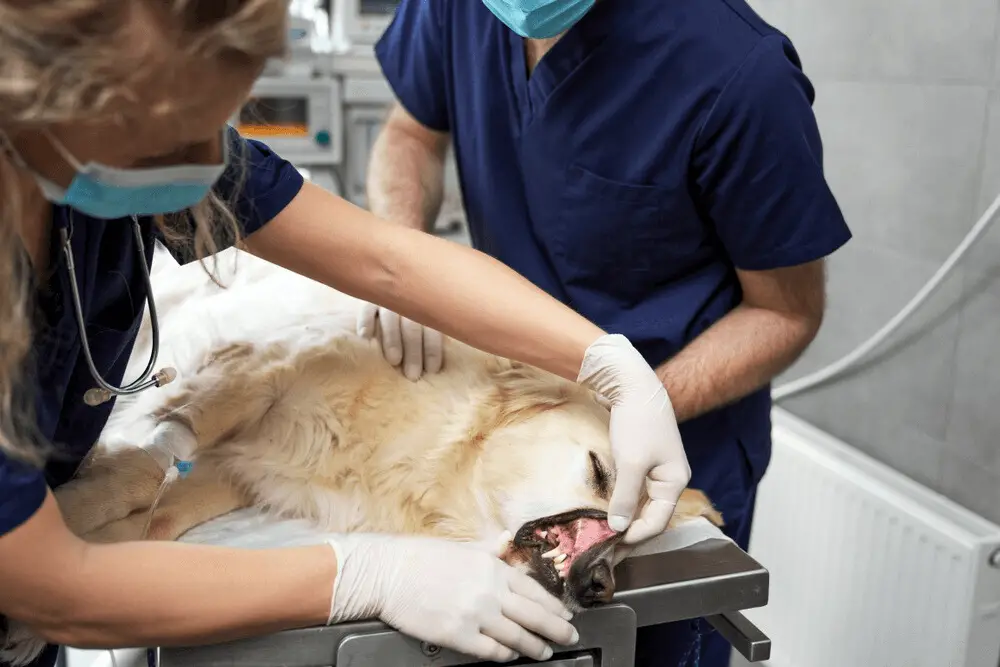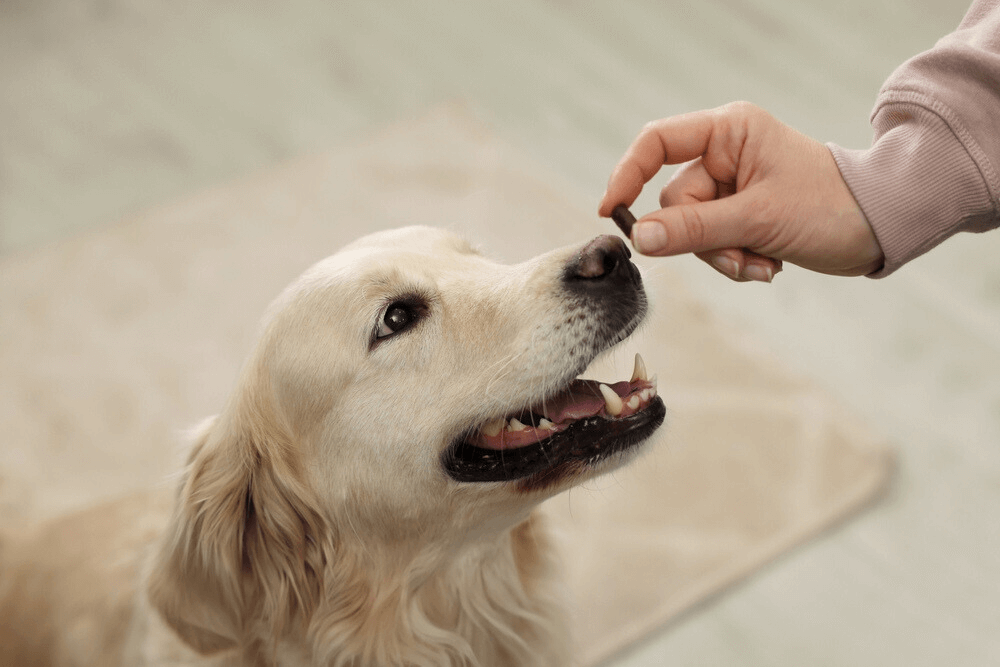If you’re like most pet parents, you want to do everything you can to ensure a speedy and healthy recovery for your furry friend after surgery. One important part of at-home care is giving your dog their prescribed medication, which may include pills.
Giving a pill to a dog can sometimes be a challenge, but with a little patience and practice, it can be done. Here are a few tips on how to give a dog a pill after dental surgery:
Preparing to Give Your Dog a Pill
For anyone who has ever had to give their dog a pill, the process can be daunting. Will your dog cooperate? How will you get the pill into their mouth without making a mess? And what if they end up spitting it out?
Here are a few tips to make giving your dog a pill a little less stressful:
1. Have everything you need ready before you start. This includes the pill, a treat, and a cup of water.
2. Get your dog in a sitting or standing position. You may need to have someone help you hold them still if they are wiggly.
3. Open your dog’s mouth and place the pill as far back on their tongue as you can.
4. Close your dog’s mouth and hold it shut for a few seconds. Rub their throat to encourage them to swallow.
5. Give your dog the treat and a few sips of water. This will help to make sure the pill goes down.
6. Reward your dog with lots of praise and petting. They did a good job!
What to Consider Before Giving Your Dog a Pill After Dental Surgery
There are a few things to consider before giving your dog a pill. First, is your dog the right size for the pill? Some pills are too large for smaller dogs and could make them sick. Second, does your dog have any allergies? Some dogs are allergic to certain ingredients in pills, so it’s important to check with your vet first. Finally, does your dog have any medical conditions that could be exacerbated by taking a pill? Certain medical conditions, such as liver or kidney disease, could be made worse by taking a pill, so it’s important to check with your vet first.
Ways to Make Giving a Dog a Pill Easier
Giving a dog a pill can be a tricky process, but there are a few things you can do to make it easier. Here are a few tips:
1. Give the pill with food. This will help to mask the taste of the pill and make it more palatable for your dog. You can also try wrapping the pill in a piece of cheese or another favorite treat.
2. Use a pill pockets. These are little pockets made specifically for holding pills, and many dogs will happily take them.
3. If your dog is resistant to taking pills, you may need to give them the pill in a gel form. This can be done by mixi
Alternative Ways to Give Your Dog a Pill
We all know that giving our dogs pills can be a real challenge. They always seem to know when we’re trying to sneak one past them and will do everything in their power to avoid taking it. But there are actually a few different ways that you can give your dog a pill that may be more successful than the traditional method.
One way is to mix the pill with a small amount of food. This works well if your dog is food-motivated and will eat just about anything. Simply crush the pill into a powder and mix it in with a tiny bit of their food. If they’re anything like my dog, they’ll gobble it right up without even realizing there’s a pill in there.
Another option is to hide the pill in a treat. This is similar to the previous method, but you’ll want to use a treat that’s a little more special than their normal kibble. Something like a small piece of cheese or a bit of hot dog should do the trick. Just make sure the treat is small enough that they can eat it quickly and won’t have time to realize there’s a pill inside.
If your dog is particularly smart and savvy when it comes to pills, you may need to get a little creative. One way to do this is to wrap the pill in a piece of meat and then roll it into a little ball. This way, they’ll be getting a tasty treat and won’t even realize there’s medication inside.
Finally, if all else fails, you can always try the old-fashioned method of placing the pill in the back of their throat and then giving them a small amount of water to help wash it down. This isn’t always the most pleasant experience for either of you, but sometimes it’s necessary.
No matter which method you use, always make sure to keep an eye on your dog after giving them a pill to make sure they don’t spit it out or vomit it up. And if you’re ever in doubt, always consult with your veterinarian before giving your dog any medication.
How to Tell If Your Dog Has Taken the Pill
If your dog has taken the pill, there are a few things you can look for to be sure. First, check to see if the pill is missing from the bottle. If it is, then your dog has probably taken it. You can also check your dog’s mouth to see if the pill is there. Finally, watch your dog for any changes in behavior. If your dog seems tired or lethargic, it may be due to the pill.
Diet When Giving Your Dog a Pill
It can be tricky to get your dog to take their medication, especially if it’s a pill. Here are some tips on how to make the process a little easier.
First, it’s important to talk to your veterinarian about the best way to give your dog their pill. They can offer insights based on your dog’s individual health needs.
Once you have a plan, there are a few things you can do to make sure your dog takes their pill.
Try hiding the pill in their food. This is often the easiest way to get them to take it. You can mix it in with their regular food, or try using a little bit of peanut butter or cream cheese as a “binder” to make sure they eat the whole pill.
If your dog is resistant to taking pills in their food, you can try giving it to them in a treat. Pill pockets are a great option, or you can make your own by puttin
What can I feed my dog after dental surgery?
After your dog’s dental surgery, it’s important to give them the proper nutrition to help them recover. Here are some ideas of what to feed your dog after dental surgery:
1. Soft food: Soft food is easy on the teeth and gums and is a good option for dogs who have had dental surgery. You can either cook up some soft food at home or buy commercial dog food that is designed for dogs with dental problems. Just make sure that the food is not too high in fat or salt.
2. Soup: A warm bowl of soup can be soothing for your dog’s sore throat and gums. Just make sure that the soup does not contain any onions or garlic, which can be harmful to dogs.
3. Yogurt: Plain yogurt is a good source of protein and calcium, and it can help soothe your dog’s tummy after surgery. Just make sure to avoid yogurts that contain fruit or sweeteners, as these can be harmful to dogs.
4. Eggs: Eggs are a good source of protein and other nutrients, and they can be easily mashed up for dogs who are having trouble eating solid food. Just make sure that the eggs are fully cooked before giving them to your dog.
5. Cottage cheese: Like yogurt, cottage cheese is a good source of protein and calcium. It can also be mashed up for dogs who are having trouble eating solid food. Just make sure to avoid cottage cheese that contains fruit or sweeteners.
6. Boiled chicken: Boiled chicken is a good source of protein and other nutrients, and it can be easily mashed up for dogs who are having trouble eating solid food. Just make sure that the chicken is fully cooked before giving it to your dog.
7. Canned salmon: Canned salmon is a good source of protein and omega-3 fatty acids, which can help reduce inflammation. Just make sure to remove the bones before giving it to your dog.
8. Steamed vegetables: Steamed vegetables are a healthy option for dogs who are trying to eat solid food after surgery. Just make sure that the vegetables are not too salty or spicy.
9. Ice chips: Ice chips can help soothe your dog’s throat and gums after surgery. Just make sure that the ice chips are not too hard or large, as they could damage your dog’s teeth.
10. Water: Make sure to keep your dog hydrated after surgery by offering them fresh water at all times. You may also want to add some ice chips to their water bowl to help keep their throat and gums cool and hydrated.
Addressing Side Effects and Complications After Dog Dental Surgery

It’s no secret that dental surgery in dogs can be a tricky business. Not only is it a sensitive area for your dog, but there are also a lot of potential complications that can arise. Here, we’ll be talking about some of the most common side effects and complications that can occur after dog dental surgery, and how to address them.
One of the most common side effects of dog dental surgery is bleeding. This is usually due to the fact that the gums are very sensitive and can bleed easily. If you see your dog bleeding after surgery, it’s important to apply pressure to the area with a clean cloth or gauze. You can also give your dog a ice pack to help reduce the swelling.
Another common complication is infection. This can occur if the area around the surgical site is not kept clean. Be sure to clean the area around your dog’s mouth with a mild soap and water solution every day. If you notice any redness, swelling, or discharge, be sure to contact your veterinarian right away.
Finally, one of the more serious potential complications from dog dental surgery is anesthesia complications. This can happen if your dog has a reaction to the anesthesia or if they are not properly monitored during the surgery. Be sure to ask your veterinarian about the risks of anesthesia before surgery and follow their recommendations for post-operative care.
If you take all the necessary precautions and follow your veterinarian’s instructions, the chances of complications after dog dental surgery are very low. However, it’s always important to be aware of the potential risks so that you can take steps to avoid them.
Knowing When to Seek Veterinary Care After Dog Dental Surgery
It’s important to know when to seek veterinary care after your dog has had dental surgery. Here are some things to look for:
- Excessive bleeding from the surgery site
- Swelling that lasts longer than a few days
- pus or drainage from the surgery site
- redness, heat, or discharge from the surgery site
- a foul smell coming from the mouth
- Your dog is not eating or drinking
- Lethargy or depression
- Vomiting
- Fever
If you notice any of these things, it’s important to seek veterinary care right away. Your dog’s mouth is a sensitive area and any infection can quickly become serious.
Consulting Your Vet for Extra Guidance
Consulting your veterinarian for help and guidance is always a smart move when it comes to the health of your pet. veterinarians are highly trained and experienced in all things related to animal health, and they can offer invaluable insights and recommendations when it comes to keeping your pet healthy.
There are a few key things to keep in mind when you consult your veterinarian for help. First, be sure to describe all of your pet’s symptoms in as much detail as possible. This will help your veterinarian narrow down the potential causes of the problem and develop a treatment plan.
Next, be honest about any changes in your pet’s habits or behavior. Even something that seems minor, like a change in appetite, can be significant. Finally, be sure to ask lots of questions! Your veterinarian is there to help you, and they’ll be happy to answer any questions you have.
So, don’t hesitate to consult your veterinarian for help when it comes to your pet’s health. They’re the experts, and they can offer invaluable guidance in keeping your pet healthy and happy.
Conclusion
The process of giving a dog a pill after dental surgery can be a challenging but essential aspect of their recovery. Ensuring that your furry companion receives their prescribed medication is crucial for their comfort and well-being. By following the advice of your veterinarian and employing various techniques such as using pill dispensers, treats, or pill pockets, you can make the task more manageable.
Additionally, it’s vital to maintain open communication with your vet throughout the recovery period, seeking their guidance on medication administration and any concerns you may have. Always adhere to the recommended dosages and schedules provided by your veterinarian to promote a smooth and successful recovery for your beloved pet.
Remember, the well-being of your dog is of utmost importance, and with patience, persistence, and professional guidance, you can ensure that the post-dental surgery medication process is as stress-free as possible for both you and your furry friend. Your dedication to their care plays a significant role in their path to a healthy and happy life post-surgery.
Frequently Asked Questions (FAQs)
Q: How soon after dental surgery can I give my dog a pill?
A: You should wait for the recommended time given by your veterinarian, usually a few hours after surgery, to ensure your dog is fully awake and alert.
Q: What's the best way to give a dog a pill if they resist?
A: Try using a pill dispenser or hiding the pill in a treat, or use a pill pocket designed for easy medication administration.
Q: Are there any signs of complications I should watch for after giving the pill?
A: Watch for any unusual behavior, vomiting, or adverse reactions. Contact your vet immediately if you notice any concerning symptoms.
Q: Can I give multiple medications at once?
A: It’s crucial to consult your veterinarian before giving multiple medications simultaneously to ensure they won’t interact negatively.
Q: How long will my dog need medication after dental surgery?
A: The duration of medication will depend on your dog’s specific needs and the type of surgery. Follow your vet’s prescribed schedule.
Q: What if my dog refuses to take the pill no matter what I try?
A: If your dog consistently refuses medication, consult your vet. They may offer alternative medications or administration methods.
Remember, it’s essential to follow your veterinarian’s guidance closely when giving your dog medication after dental surgery to ensure their safe and comfortable recovery.

